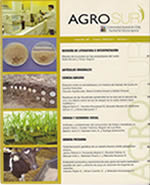Effect of defoliation frequency on yield and nutritional composition of Pennisetum clandestinum Hochst.ex Chiov
Main Article Content
Abstract
In Colombia at 2,560 m.a.s.l. the effect of three defoliation frequencies (3, 4.5 and 6 leaves tiller-1) was evaluated, during four months (August - November), on growth and nutritional quality of Kikuyu (Pennisetum clandestinum Hochst.ex Chiov). Nine plots of 6 x 4 m were established, which were distributed in a complete randomized block repeated measures design. Data were subjected to analysis of variance. A significant interaction between defoliation frequency and the month of utilization on total herbage mass yield and crude protein concentration was observed. The highest values for both variables were obtained at 6 leaves tiller-1 in October (herbage mass) and OctoberNovember (crude protein). Defoliation frequency did not modify yield components (proportion of blades, sheath, stems and dead material). Neutral Detergent Fiber and Acid Detergent Fiber were not affected by defoliation frequency. In conclusion, grazing of kikuyu swards, under similar environmental conditions of this study should be performed at stage of 4.5 to 6 leaves tiller-1 with a residual sward height of 5 cm.

